Suzanna's Brother Paul & Stefanie Travel to Isreal and Jordan in 2003
A Walking Tour of The Bible
I hope you enjoy this walking tour of the Bible gleaned from our recent trip to Israel and Jordan. Can you believe that we saw sights going as far back as the book of Genesis?
01 Laish gate
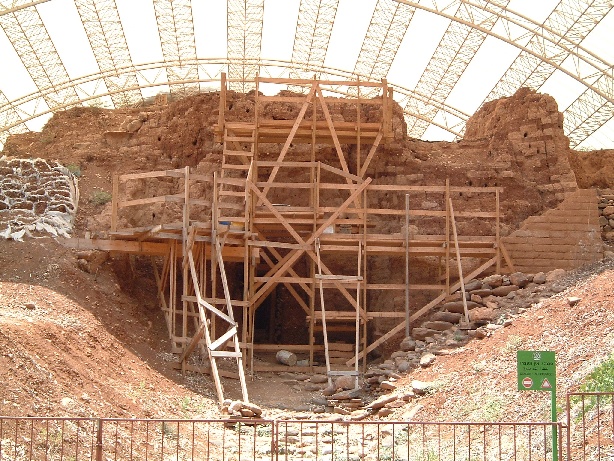
This is one of the worlds oldest gates. When Abraham rescued his nephew Lot in Genesis 14 he probably walked through this gate to enter the city of Laish (now known as Dan). This gate is still preserved today because they covered it with packed earth to protect it from battering rams. The dirt preserved the gate.
02 Bedouins

Did you know the Patriarchs lived in tents? They lived like Bedouins. Bedouins are a nomadic people that do not recognize international boundaries. They have no law or government except the law of the desert. Bedouins will offer hospitality and protection to travelers for three days, no questions asked. Abraham acted on the law of the desert when he rushed to welcome and feed the angels in Genesis 18.
Most Bedouins live in dark brown or black tents in the desert. In the winter, the hills are green. Sometime in March, a hot wind blows from Saudi Arabia searing the vegetation almost overnight. It leaves the land barren like you see here. The Bible refers to this wind.
The grass withers, the flower fades, but the word of our God stands forever. Isaiah 40:8.
03 Mt. Moriah
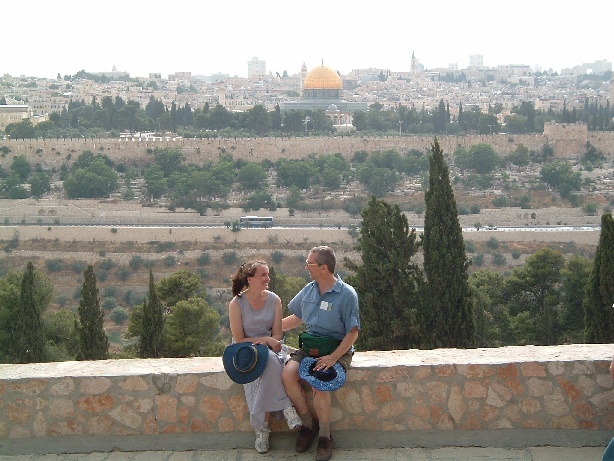
This is Paul and I in front of Mount Moriah. In Genesis 22, we read that Abraham prepared to sacrifice his son Isaac on Mount Moriah. You are going to see a lot of this Mountain as we walk through the Bible.
04 Jabbok River
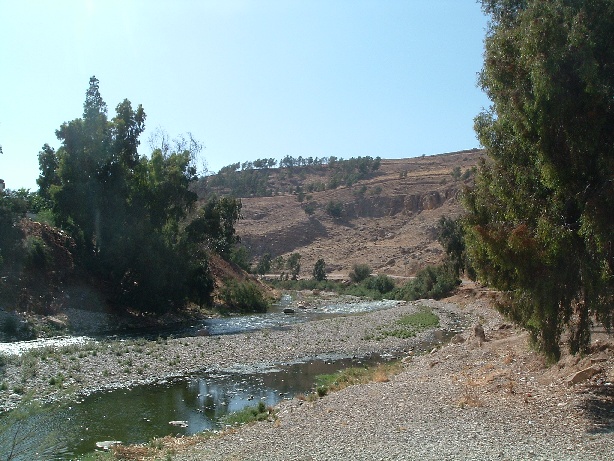
Jacob wrestled with God at the Jabbok River in Genesis 32. We walked across this river in Jordan.
Lets pause right here for a moment. I didnt go the Holy Land to see the Jabbok River. If you had asked me, I wouldnt have remembered reading about it. Our trip to Israel gave me a greater appreciation for the detailed accuracy of the Bible. Our Tour Director, Dr. Randall Price, wrote that the Bible contains a spiritual message in a historical context. And right now, youre walking through history!
Jacob married Rachel. While in Bethlehem we passed by Rachels tomb. The Jews believe they know where Rachel is buried, and today they consider it their third holiest site. It also contains get this -- the tomb covers for Joseph and his sons, Manasseh and Ephraim. How awesome is that?
We did not go to Rachels tomb. Therefore, I do not know if our Tour Director, Dr. Price would vouch for its authenticity. So now is a good time to give you a caveat.
Our guides gave us a four-point scale to keep in mind when viewing sites in the Holy Land:
One -- Its Biblical and we know it happened here.
Two -- Its Biblical and it probably happened here, but we cant prove it did.
Three -- Its Biblical, but it probably didnt happen here, but we cant prove it didnt. (These are usually sites supported by long-standing church tradition.)
Four -- Its a myth.
So far weve talked about Abraham, Isaac and Jacob. Our tour director in Bethlehem attends a church that still speaks the same Biblical language of Abraham, Isaac and Jacob. Wow! That makes the lives of the Patriarchs seem a whole lot closer.
Moving on, would you be surprised to know that there is very little archaeological evidence for Moses, the Israelite captivity or the Exodus?
Dr. Price wrote that the absence of evidence is not evidence of absence. If archaeology does not support the Biblical record its because archaeologists are limited, not the Bible. According to Dr. Price, Israel is full of archaeological mounds called tells. Of all the tells that have been surveyed, only 2 percent have been excavated. Only a fraction of the tell is actually examined, and only a fraction of what is examined is ever published. Therefore, we cannot look to archaeology to form our faith, but it can inform our faith. That is what I hope to do tonight.
So what did we see from the Exodus period? Exodus 13:17 tells us that God forbade the Israelites to take the shortcut to Canaan. God knew they might want to go back to Egypt if they had to fight. Paul and I saw Egyptian artifacts proving that the Egyptians kept military outposts in the area around the Red Sea. The long route Moses took avoided those outposts.
God told Moses to build the tabernacle in the wilderness. Paul and I saw a great reconstruction of what the tabernacle would have looked like.
05 Sacrifice

The priests slaughtered the animals here and prepared them for sacrifice. The metal rings in the floor held the animal.
Incidentally, I read that the Hebrew word for sacrifice, korban, does not mean giving up something. It meant to come near or to approach. They sacrificed animals not to give something valuable to God, but so that they could draw near to God.
06 Bronze Laver and Brazen Altar

The priests washed their hands and feet at the bronze laver on the left before entering the Holy Place or approaching the bronze altar on the right to burn the sacrifice.
The bronze altar pictured here is where they burned the sacrifice for atonement of sin. Once the priests had clean hands through the bronze laver, and a pure heart through the burnt offering, then they could draw near to God in the Holy Place where God dwelt.
07 Ark
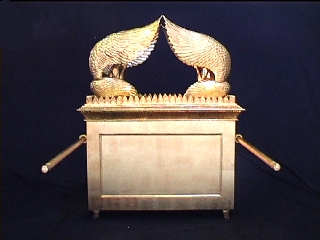
We dont know precisely what the ark looked like. It contained the Ten Commandments, Aarons rod and the manna. Randall Price believes it also contained the first set of commandments that Moses broke because the people sinned. Taken together, the contents remind us of mans rebellion and Gods provision.
The cherubim probably looked down on the ark, representing God looking beyond our sin and rebellion and seeing instead the blood of the sacrifice sprinkled on the mercy seat.
Get This. Israeli scholars believe they know where the ark is. They think the Israelites hid it in a secret chamber underneath the temple. Unfortunately, archaeologists cant go digging for it, because Muslims control the Temple Mount.
I did a wonderful Bible study on the tabernacle written by Beth Moore. She wrote that if you want to see the New Testament tabernacle, look in the mirror! Corinthians 3:17 says that Gods temple is sacred, and you are that temple. You are a sacred dwelling place! That body you might like to trade in for a newer version is sacred!...He is God. He could have made His sanctuary in the farthest galaxiesbut He chose to live in you and me. You are now the way He dwells [or tabernacles] among the people of this world.
08 Brazen Cross

A brazen cross like the one Moses made in the book of Numbers.
I learned something new when I looked at this cross in Jordan. I always understood that the Israelites would live if they looked to the snake on the pole, just as we receive eternal life when we believe in Jesus.
What I didnt realize, was that the serpent on the pole also showed the Israelites need for forgiveness from sin as well as salvation from death. (The serpent on the pole could represent the serpent in the garden that led Adam and Eve to commit the first sin.)
09 Mt. Nebo

Moses walked up Mt. Nebo to view the Promised Land before he died. It seemed like a steep hike for a 120-year-old man. This sign on Mt. Nebo shows what Moses would have seen.
Incidentally, another tradition has it that the Ark is hidden under Mt. Nebo until the second coming of Christ.
10 Dan Springs

When Israel conquered the promised land, the Tribe of Dan ended up in the far north. Lucky Dan, they were near one of the sweetest springs in the world, the Dan springs. This is now inside the Tel Dan Nature Preserve. There are many ancient ruins at this location that we will see later.
11 Beth-Shean

Right now were walking with Saul. Sauls reign began and ended near Beth-Shean. His first military decision was to attack the Ammonites attacking the City of Jabesh (near Beth-Shean). He fought his last battle against the Philistines at Mt. Gilboa. Saul committed suicide after the Philistines defeated his army and killed his sons. The Philistines hung the bodies of Saul and his sons on the wall of Beth-Shean.
12 Bricks

Over the centuries, many civilizations conquered Beth-Shean. If you look closely at these ancient bricks, youll see bits of straw. These are Egyptians bricks. They are similar to those the Hebrew slaves made. That is because the Egyptians once inhabited Beth-Shean.
13 23rd Psalm

Were now walking with David. Is this what you picture when you hear Psalm 23?
Our Israeli tour director, Hal Ronning, takes Bible translators here so they can see the context of Psalm 23.
The Lord is my shepherd, I shall not be in want.
He makes me lie down in green pastures,
He leads me beside quiet waters,
He restores my soul.
I always pictured David leading his flocks over green pastures to gently flowing streams. Instead, green pastures and quiet waters are rare. Yet David trusts God to provide him these things.
14 Goat Paths

This picture is actually from Jordan, but this picture clearly shows how the goat paths circle the hillsides, one path on top of another. The flock would quickly die without a shepherd to show them which path to take to green pasture and quiet waters.
In Davids day, huge desert ravines lay between the hills. The ravines had lions, bears and other predators. Between the predators, and the harsh climate, these truly were valleys of death. But David learned to fear no evil because he knew that God was with him.
15 En Gedi

David hid here in En Gedi or the crag of the wild goats. Normally it is a lush spring in the middle of the hot desert. Unfortunately a fire burned it the day before our visit. Seeing En Gedi was an Aha! moment. If I were hiding in the middle of a desert, like David, I would certainly hide in a cave near the only water sourceEn Gedi. If I were King Saul, wandering the desert looking for David, I would certainly stop at En Gedi to fill up my water bottles. No wonder King Saul walked into Davids cave.
There are surprisingly few archaeological remains from the time of King David. For a long time secular historians doubted the existence of King David because there were so few. In one museum, we saw an Egyptian inscription that referred to the House of David. This rock helped silence the doubters.
16 Nehemiahs Wall

This is the view of the Kidron valley between Mt. Moriah and the Mount of Olives. The lower wall is from the old Jebusite era which is pre King David. Look closely at the upper wall. That is the wall that Nehemiah built!
In David and Nehemiahs days, the ravine was much deeper so the walls were higher. The Jebusites felt so secure on top of their wall that they laughed at David. Our blind and the lame can defend this city against you! Oops! They spoke too soon! David conquered them.
17 Mount Moriah
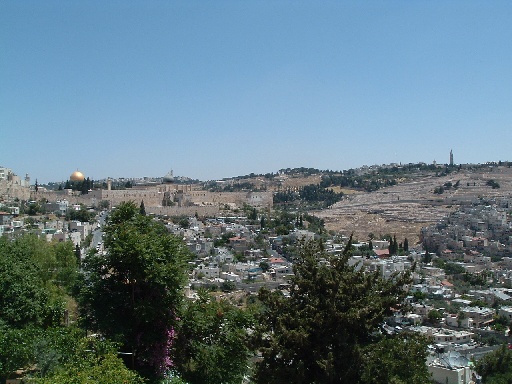
This Mt. Moriah again (under the Gold dome). Do you remember how King David took a census of his people when he should have trusted God? God sent a plague on Israel for three days but He stopped the plague at the threshing floor on Mt. Moriah. David bought the place to build an altar to God. His son, Solomon built the temple here.
To get to the temple, Jews walked up the steep Kidron Valley. The beauty of the temple beckoned high above them from Mt. Moriah. So when the Bible talks about worshipping Him on high or going up to the House of the Lord it has a literal meaning referring to worshipping God high on top of Mount Moriah.
Downhill from Mt. Moriah, toward the bottom of the picture is Mount Zion, the site of the original City of David. David might be buried here.
Later, Zion took on a spiritual meaning. Zion is the place where God dwells or heaven. I dont know about you, but that used to confuse me when I read the Old Testament. Is Zion a literal place or figurative? Well, its both.
Today, when Israelites refer to Mt.Zion, they mean across the Kidron Ravine opposite from the temple. They think David is buried there.
18 Hinnom Valley

Just like Zion came to have a spiritual meaning so did the valley of Hinnom, or Gehenna. Here the Israelites burnt their garbage --and their children. In Jeremiah 19, God tells Jeremiah to prophesize against the Hinnom Valley because the Jews sacrificed their children to pagan idols here. Because of the flames and the smell, Gehenna later came to have the broader meaning of Hell.
19 Pool of Siloam

Were still in the time of David. While King David lay dying, his son Adonijah celebrated at the Kings Garden next to the Pool of Siloam. Meanwhile, David named Solomon his heir. So while Adonijah partied, a priest anointed Solomon in the Gihon Springs. Today, the Gihon Springs feeds the Pool of Siloam that you are looking at.
The Pool of Siloam is also where Jesus healed the blind man. So we walked where Jesus walked. They have been excavating this site for just one year. Dr. Price observed, Isnt it amazing how the Bible confirms archaeology and not the other way around?
Dr. Randall Price is also an archeologist. We could only see this dig because of professional courtesy, one archaeologist to another. No other American tour group could have entered this site.
20 Solomons Gate

Now were walking in King Solomons footsteps! King Solomon built a fortress on the Hill of Megiddo. Dr. Price is 99 percent sure that Solomon walked through this gate.
21 Temple at Dan

Nearly all archaeologists agree that this excavated podium was the place that Jeroboam built the golden calf at Dan. The metal structure you see is an outline of the altar he built. According to our guide, Jeroboam built the golden calf because he wanted to find a religious symbol from their past to compete with the ark in Jerusalem.
Our guide drew a moral lesson here. We should not live or worship according to the ways of the world. We need to ask ourselves, is the God we are worshipping the God of the Bible, or a God of our own creation, like the golden calf?
22 Judgment Seat
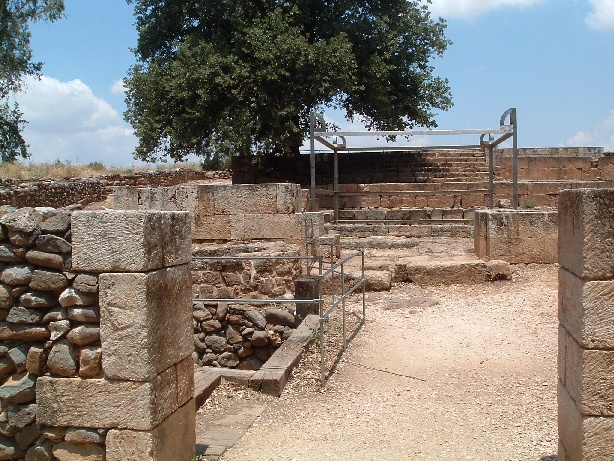
Were walking quickly through the Old Testament. King Ahab built this judgment seat and gatehouse, which is also in Dan. Justice took place in the gates of the city. Randall Price noted that the Hebrew word bema used for the judgment seat at the citys gate is the same word the New Testament uses to refer to the Judgment Seat of Christ.
Unfortunately, the gatehouses also became high places. On the left of the judgment seat you can see a pointed, upright stone. Dr. Price believes this may have been an idol to the pagan God Asherah.
23 Hezekiahs Tunnel
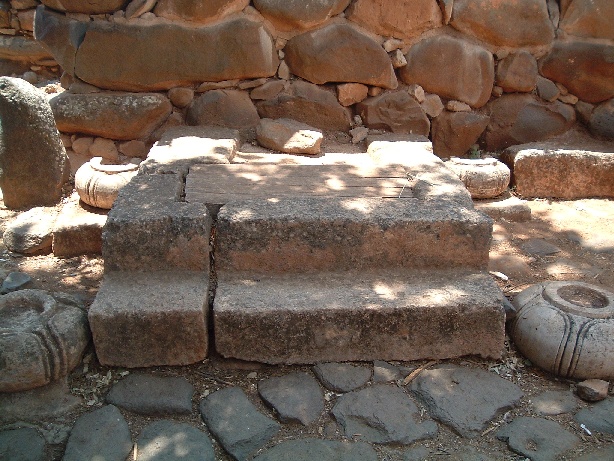
We dressed up in swimsuits and water shoes and headed off for a water park Israeli style. Hezekiah built a water tunnel in 701 B.C. to channel water from the Gihon Springs into Jerusalem. He wanted to protect the water supply so Jerusalem could withstand an Assyrian siege. So as we walked through this tunnel we walked through history.
24 Petra Entrance

This is the entrance to the Edomites fortress in Petra. The prophet Obadiah predicted its destruction when he said:
The pride of your heart has deceived you, you who dwell in the clefts of the rock, whose habitation is high; you who say in your heart, 'Who will bring me down to the ground?' Though you ascend as high as the eagle, and though you set your nest among the stars, from there I will bring you down," says the LORD. Obadiah 1:3-4.
This prophecy was fulfilled when their allies, the Nabateans, destroyed the Edomites.
Walking in the desert heat to the one mile, narrow cleft that led into Petra, it was easy to see why the Edomites were so confident. It would be hard for an army to attack through this narrow entrance.
After walking one mile, this is what we saw.
25 Tomb Tunnel View
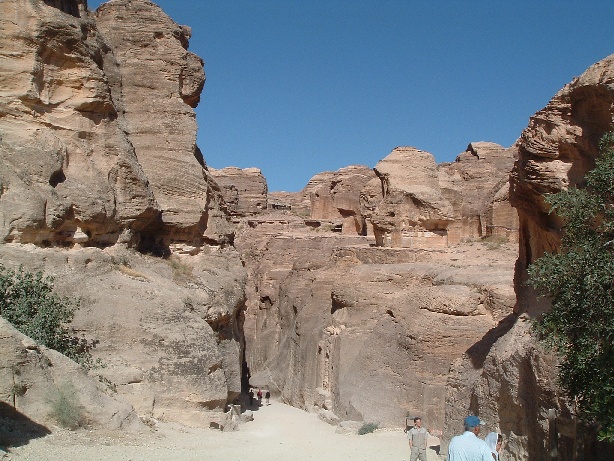
26 Petra Tomb
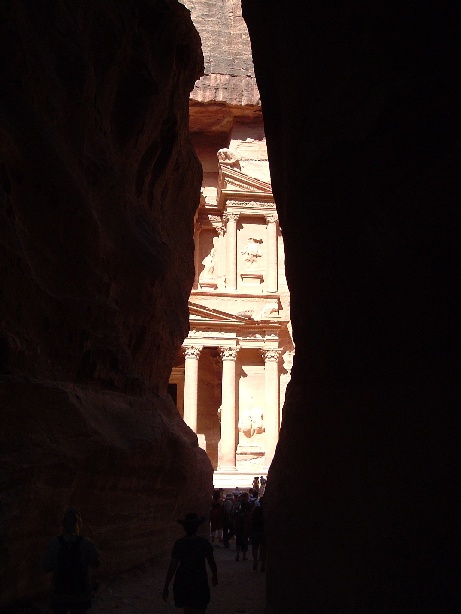
Then we saw this. It is an old tomb. So far they have only uncovered tombs inside Petra which is why it is sometimes call the city of the tombs.
27 Monastery
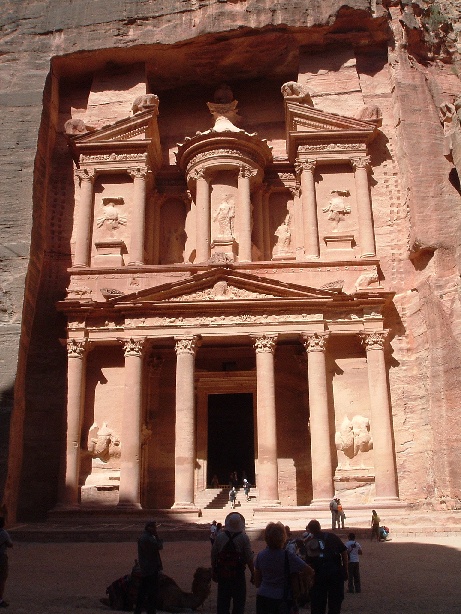
At Petra we walked seven miles. This last stretch was a steep climb, including more than 800 steps. Who needs a stairmaster? Others in our group chose to rent donkeys.
28 Petra Donkeys

Paul had nothing but disdain for the scrawny Jordanian donkeys. Their owners kept calling to us, Mister, Mister, you want a taxi?
Paul said: Your donkey small, my donkey big! They didnt believe an American owned a donkey.
Many Christians who study Biblical prophecy believe that during the end times there will be a big battle in Jerusalem.
29 Mount of Olives

Speaking of prophecies, this is the Mount of Olives. Thousands of Jews are buried here.
Zechariah 14:4 predicts that the Messiah will return to the Mount of Olives and it will be split in two so the Jews can escape into the desert. A jewish person doesnt believe that Jesus is the Messiah, but they still believe this Messianic prophecy. They believe that the Messiah will descend the mountain and enter Jerusalem. So, if they are buried on the Mount of Olives, they will be 'first in line' to rise from the dead.
Did you know that Israel has a major fault line running north to south? The Sea of Galilee, the Jordan Valley and the Dead Sea are all part of a rift valley formed by two tectonic plates rubbing against each other. This is fact. Here is a number 3 or 4, a statement somewhere between we cant prove it wrong, and an outright myth. Some websites report that a hairline fault runs East-West from the Rift Valley through the Mount of Olives. They speculate that this hairline fault will split the Mount of Olives, fulfilling the prophecy in Zechariah 14.
30 Qumran Caves

Weve almost walked to the New Testament. Getting tired yet? We are now between the Testaments. If youve heard of the Dead Sea Scrolls they were found in Qumran in caves like the one in the lower right corner.
31 Dead Sea Scroll Also see: Suzanna Travels to the Dead Sea Scrolls.

The scrolls contained 233 copies of Old Testament books. Some were 1,000 years older than our earliest Biblical manuscripts. They prove that our Old Testament Bible is amazingly accurate:
The text is word-for-word the same 95 percent of the time. The remaining five percent are obvious slips of the pen like spelling errors.
32 Qumran Settlement

This is Qumran. A Jewish sect called the Essenes lived here before and after the time of Christ. They thought the Jews in Jerusalem were corrupt. So they set up a community in the desert near the Dead Sea and devoted themselves to ritual purity and the study of the scriptures.
33 Copper Scroll

The copper scroll found at Qumran is intriguing. Like a story out of Indiana Jones and the Temple of Doom, this scroll is a treasure map, marking where the Essenes hid their gold, silver and valuables. The theory is that the Essenes feared the Romans would attack them, so they hid their stuff until they could come back for it but they never got a chance. And the archaeologists are still looking for the secret hiding places.
These scrolls were found at very symbolic times. Randall Price is convinced that God was at work to show the world that God will keep his promises to Israel.
Archaeology and the Nation of Israel
- In 1947, a scholar was reading the Isaiah scroll for the very first time when he got to a passage promising the restoration of Israel, and at the exact moment, the radio announced the formation of the state of Israel.
- The temple scroll was discovered in Bethlehem on the same day the Temple fell into Jewish hands in the 1967 war.
34 Church of the Nativity
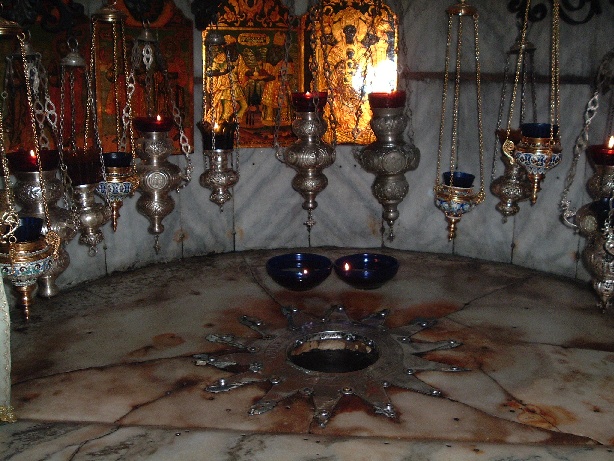
Were finally walking into the New Testament. Most scholars believe the Church of the Nativity is a number one, its Biblical and they believe Jesus was born here.
This altar marks the spot where Jesus was born. The grotto contained a manger where Mary might have placed the baby Jesus. The original manger is in Italy.
35 Manger
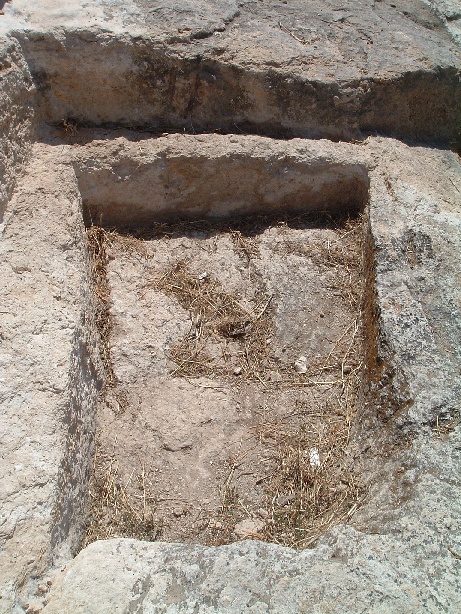
Here is what the manger might have looked like.
After leaving the Church of the Nativity, I overheard one teenager tell another, that a vendor had called out to her, I give you 200 camels to marry me!
When the girl ignored the vendor, he cried, Im serious, listen to me.
The young woman who so callously refused this generous proposal said, That was nothing. The last one offered me $5,000!
36 Shepherds Field
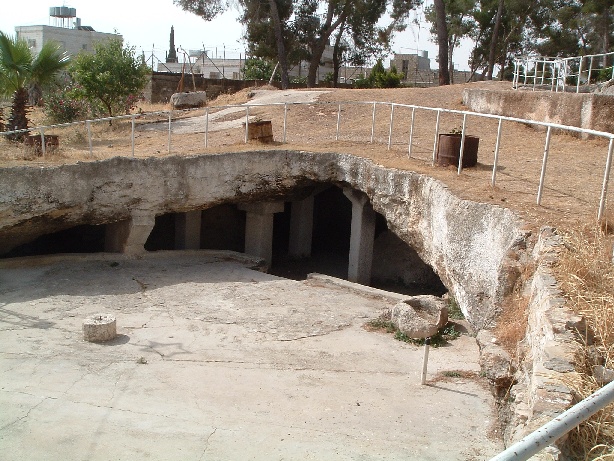
A Palestinian tour director promised to take us to THE shepherds field. Of course, it was the Protestant Shepherds Field, the Catholic and Greek Orthodox churches have their own shepherds fields. As for me, the Palestinian tour director said, I believe all three!
The one and only Protestant Shepherds field actually seemed to fit the bill. It had a cave where the shepherd could have pastured his flock at night to protect them.
This is the same area where Ruth gleaned in the fields of Boaz. She passed through the Moabite mountains and walked to Bethlehem. I had always pictured this as a huge trip and a tribute to her faithfulness to her mother-in-law, Wither thou goest I will go. It actually looked like a short journey.
37 Temple Mount Southern Entrance

Since Jesus was circumcised in the temple on his 8th day, this seems as good a place as any to discuss the temple.
These steps at the Southern Entrance led into the Court of the Gentiles. You can still see the archways that were bricked over. When we walked here, we were walking where Jesus walked! And Peter. In the book of Acts, Peter preached here and 3,000 were converted and baptized.
38 Temple Mount Baptismal Site

Conveniently, these baptismals at the southern entrance were available to baptize Peters new converts. The Jews (and Jesus!) bathed themselves here in pure rainwater before entering the temple. You can see two sets of stairs. You would walk down the dirty side, cleanse yourself, and carefully walk up the other side, the clean side, before entering the Court of the Gentiles.
39 Temple Destruction
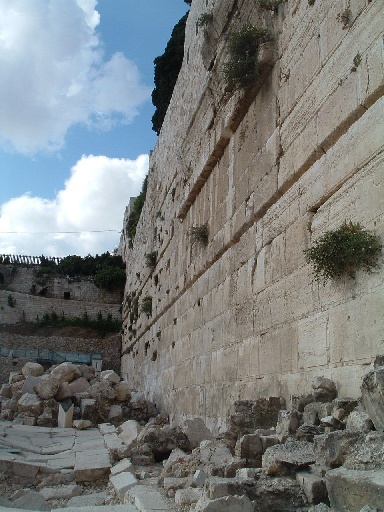
In this picture, you can see boulders that the Romans soldiers threw down when they destroyed the Temple. You are looking at one of the outer retaining walls of the Temple Mount.
Jesus prophesied: You see all these, do you not? Truly, I say to you, there will not be left here one stone upon another, that will not be thrown down.
Randall Price said Jesus prophecy referred to the Holy Place. There is not one stone left standing from the Holy Place.
40 Wailing Wall

The Jews worship at the western retaining wall, or the Wailing Wall, because it is was the closest wall to the Holy of Holies.
Did you know the Jews are already making the implements for the New Temple they are going to build? We saw some of them at the Temple Institute, but we werent allowed to take pictures. They are making the garments for the high priest right now.
Someone asked where Israel will get priests to serve in the temple. The descendants of Kohan are the priestly line. Many Jews today are still named Kohan or Cohen. Get this! DNA can determine who is from the priestly line.
41 Temple Mount Future Temple Locations
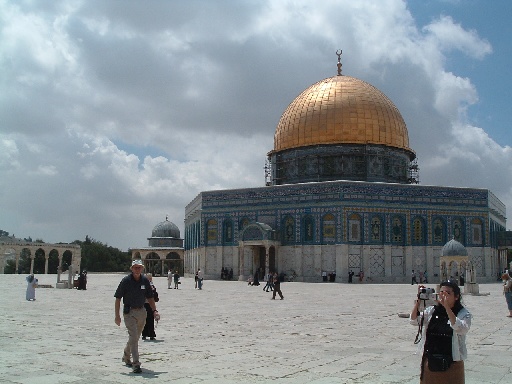
Two things prevent the Jews from rebuilding their temple.
First, the Muslims wont let them build on Mt. Moriah because that is where they have their Mosque, the Dome of the Rock. Thats what you see in this photo. It was built in 691 A.D.
Second, they dont know exactly where the Holy of Holies stood.
- It could be right under the Mosque.
- Or it might be under the smaller dome that you see in back.
- Or the Holy of Holies could have been right next to the Mosque where you can see all the pavement in front.
It could be easy for archaeologists to find out. You see the small cistern on the far left of this photo? Israeli archaeologist would love to enter it and look under the Temple Mount.
But the Muslims control the Temple Mount . They wont let Jewish archaeologists study the site. Despite the retaining walls, the boulders, the baptismals, and the southern temple entrance, the Muslims deny that a Jewish temple ever stood on Mt. Moriah.
42 Temple Mount Pavement Stones

According to our guide, the Muslims want to prevent Israel from proving that this is the original site of the second temple. Israelis believe that Muslims are doing new construction on the Temple Mount to hinder archaeologists. We saw construction workers while we were there and piles of new paving stones pictured here. Rumor has it they are building another Mosque within the Temple Mount.
43 Nazareth Village
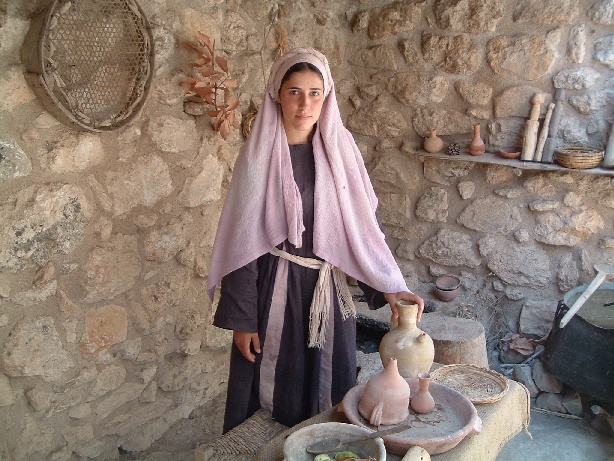
O.K. Moving on. The Nazareth village reenactment is one-half kilometer from where Jesus grew up. Here Williamsburg meets the Holy Land.
Jesus may have had his hometown in mind when he spoke the parable about the wicked tenants. They have found archaeological remains of a wine press, first-century terraces, and three watchtowers here in Nazareth. All of these are mentioned or implied in the parable:
There was a householder who planted a vineyard, [that would require terracing] and set a hedge around it, and dug a wine press in it, and built a tower, and let it to tenants, and went into another country
44 Wine Press
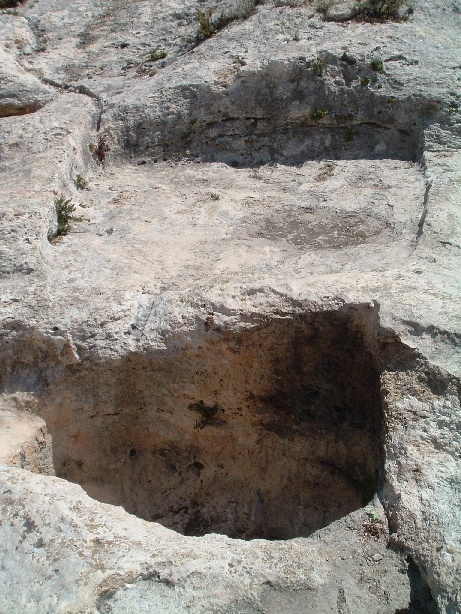
This is a wine press. Just like the I love Lucy episode, they stomped the grapes on the flat stone and the juice poured down into the vat.
45 Jesus Baptized Here (Matthew 3:16)
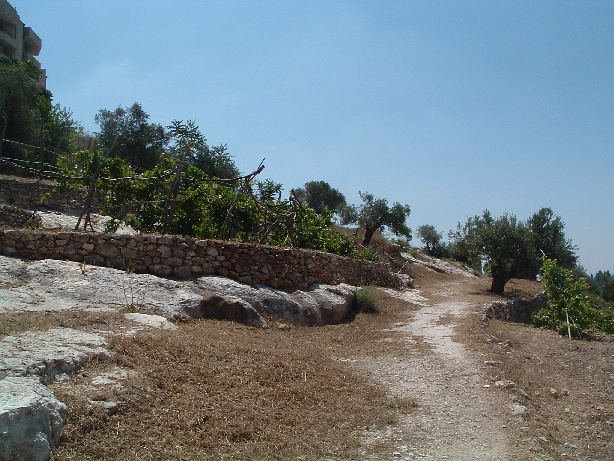
This is the east bank of the Jordan River, or where it used to be in Jesus day. We stood where Jesus might have been baptized. The wooden structures protect ruins from an early Byzantine church. So early Christians believed this is where John baptized Jesus.
I was surprised that our tour director rated this site a number two. (It is Biblical and probably happened here). Randall Price said that Jesus would have been baptized in this area, but scholars dispute whether he was baptized on the east or west bank of the river.
46 Jordan River (Matthew 3:16)
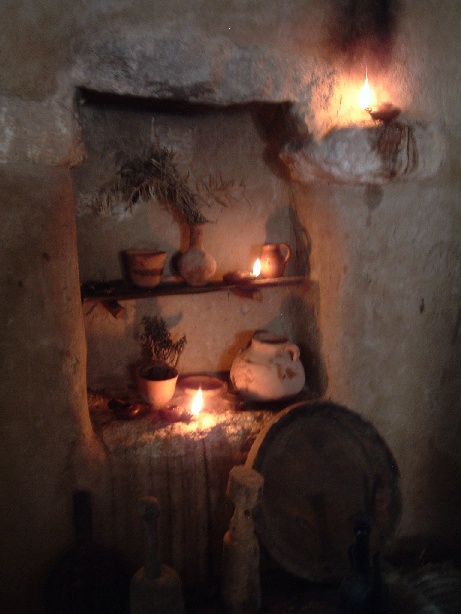
Nearly a dozen people from our tour wanted to be baptized in the Jordan River just like Jesus. It was a very moving experience. One husband baptized his wife, a father baptized his teenage son. They can go home and say they were baptized in the same river as Jesus.
47 Capernaum (Matthew 4:12)
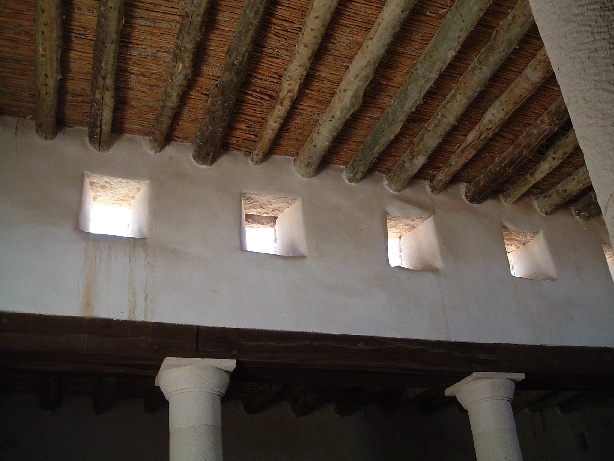
Jesus moved to Capernaum after Herod imprisoned John the Baptist. Jesus ministry started in Capernaum.
48 Sermon on the Mount (Matthew 5:1-2)
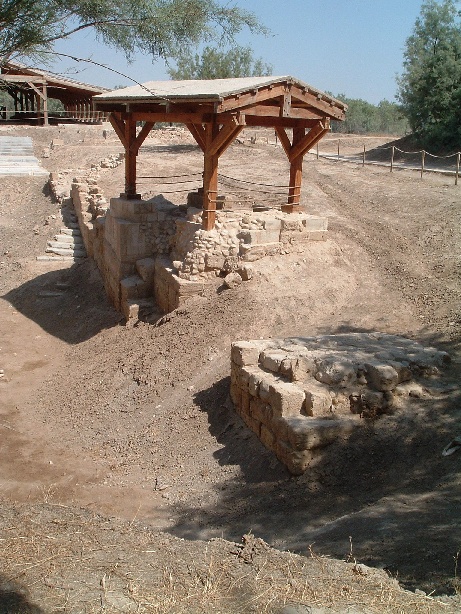
No one knows exactly where Jesus gave the Sermon on the Mount. The gospels of Matthew and Luke both state that Jesus went up on a mountain (Matthew 5:1-2, Luke 6:12). Luke 6:17 says that Jesus came down with them and stood on a level place with a crowd and a great multitude) Some scholars argue that Jesus gave the sermon containing the Beatitudes on more than one occasion, others believe that he spoke on a mountain with a level place.
The Church of the Beatitudes is built on a hill overlooking a large, gentle slope leading down to the Sea of Galilee. Thats what you see here. There is plenty of room for crowds. In March 2000, they prepared for 100,000 Catholics to observe mass here in honor of the Pope's visit.
49 Church of the Beatitudes (Matthew 5:1-2)

The present day church is octagonal to represent the eight Beatitudes. Nearby are the ruins of a 4th century church. Therefore, church tradition going back to the 4th century identified this area as a likely location for the Beatitudes.
50 Oil Lamp (Matthew 5:14)

Jesus said,you are the light of the world. A city that is set on a hill cannot be hidden. Nor do they light a lamp and put it under a basket, but on a lampstand, and it gives light to all who are in the house.
We were given a reproduction of what the oil lamps looked like in Jesus day. You can see from the picture that these oils lamps did light up the house. Paul loves to light our oil lamp because the olive oil they used emits a wonderful aroma. It makes our house smell yummy, like an Italian grandmother has been cooking in our kitchen.
51 Sea of Galilee (Matthew 8:23)

This is Paul and I sailing where Jesus sailed, on the Sea of Galilee. It is surrounded by mountains, so winds can whip up into a storm very quickly. This explains why a storm surprised experienced fishermen. The waters were very choppy the day we sailed.
52 Synagogue Roof (Matthew 9:2-8)
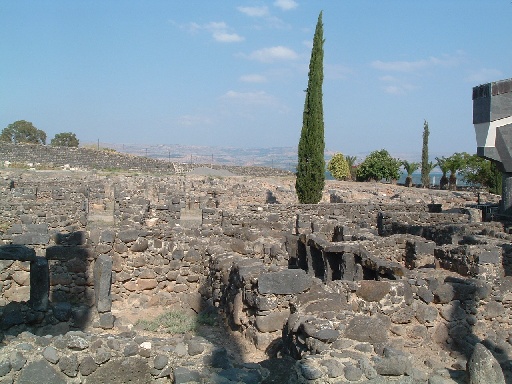
Look at this roof. This is the kind of roof that the paralytic was lowered through. The roof had supporting beams, covered with canes, and covered with a 7-centimeter thick layer of mud. In Jesus day, the beams would have been further apart. However, the engineers from the Nazareth village didnt trust 1st century building techniques. So they added extra beams for safety reasons.
Since the beams of the roof were spaced far apart, the four friends had only to dig through the mud and remove the canes to lower the paralytic man at Jesus feet. You can imagine that this would have caused a commotion. Chunks of dirt must have been raining down on Jesus as the four friends made a hole in the roof.
53 Grape Vineyard (Matthew 13)

Here you can see grapes on a 1st century terrace. Jesus parable of the sower is easier to picture when you understand terrace farming.
Every terrace is several yards wide and the sower walks the length of the terrace casting forth his seed. Since the terrace is so narrow, not every seed falls on the good soil. Some of it falls on the downhill side where the bedrock is exposed, some falls on the footpath where it is easy prey for the birds, some falls in the shallow thorny soil, and some of it falls on the deeper, good soil where it grows.
54 Herods Palace (Matthew 14:12)

O.K. we are walking where John the Baptist was killed. This is Herods Palace. Randall Price said Herod slew John the Baptist here. It is from this palace that John sent the note to Jesus asking him if he were the Messiah.
55 Banas (Matthew 16:16)

This is a picture of the temple to the Greek God Pan. The Greeks believed that Pan was the god of the underworld.
Peter made his famous confession near here: You are the Christ, the Son of the Living God.
Peter showed profound insight to profess Christ as the Son of the Living God near a site of Pagan worship.
Jesus responds, I tell you that you are Peter, and on this rock I will build my church, and the gates of Hades will not overcome it.
This could be another example of Jesus making a spiritual illustration based on his physical setting. The Greeks believed that Pan was the God of the underworld. So Pan, or the Gates of Hell, will not prevail against His church. From the Biblical text we only know that Jesus was near here, we do not know that he was actually at this Pagan temple.
56 Grinding Stone (Matthew 24:41)
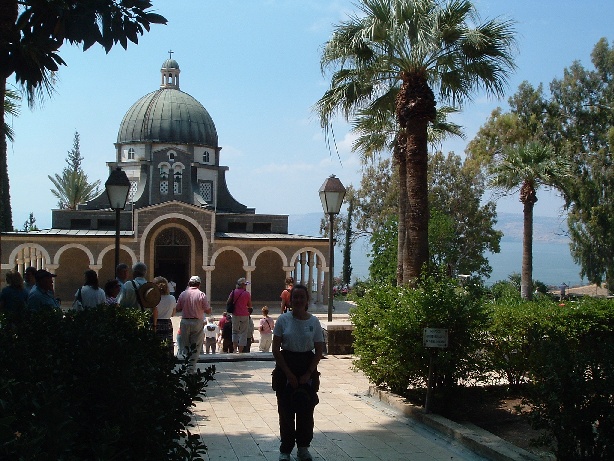
This is a two person grinding stone from Capernaum. The grinders slipped a rod through the square hole and then each grinder held one end as they walked in a circle grinding the barley. This is a picture of the verse, Two women will be grinding with a hand mill; one will be taken and the other left.
Tear Bottle Mark 14:3/Luke 7
While in Israel, I bought a tear bottle dating back to the time of Christ. Psalm 56:8 says,put my tears into Your bottle; are they not in Your book?
Remember the woman who washed Jesus feet with her tears and dried them with her hair? Randall Price believes she actually poured out her tears from her tear bottle. At Jesus feet, she no longer needed to remember her tears. She no longer needed to grieve over her past sin. Through Jesus she stood cleansed and forgiven, through faith she would receive eternal life. So, she poured her tears on Jesus feet and with gratitude dried his feet with her hair.
Unfortunately, I might have wasted my money. Some websites claim these bottles were perfume bottles not tear bottles.
57 Pool of Bethesda (John 5:1-9)
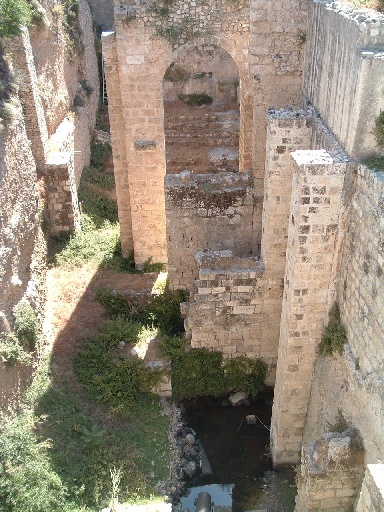
Were standing above where Jesus walked. Jesus healed the lame man here at the Pool of Bethesda. Later, the Byzantines built a church over it. Heres the funny thing, they forgot what the church commemorated. Church tradition said it was the birthplace of Mary. Archaeologists discovered the Pool of Bethesda under the church during excavations. Oops!
58 Church of All Nations
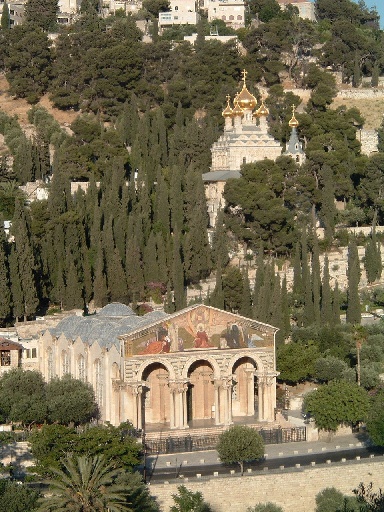
Inside the Church of All Nations is the rock where Jesus supposedly prayed in the Garden of Gethsemane. We did not go to this church.
59 Jesus Praying in Gethsemane
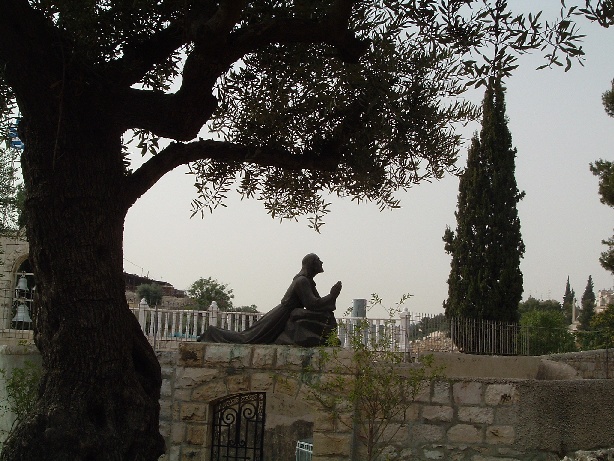
We went to another public garden on the Mount of Olives instead. They do not know exactly where the Garden of Gethsemane was in Jesus day.
60 Path to Kidron Valley

Here we are again, walking where Jesus walked! This cobblestone path led from Jerusalem across the Kidron Valley to the Pool of Siloam and to the Garden of Gethsemane. Jesus would have walked these steps if only to walk to the pool.
61 Jesus Arrest
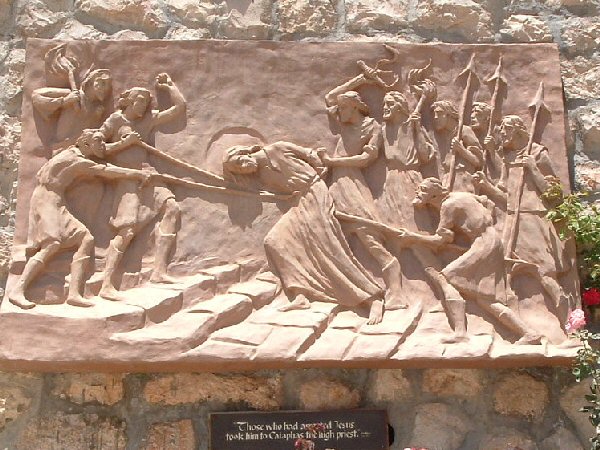
If the next picture really is Caiaphas house, then Jesus might have been dragged up these steps after he was arrested.
Unbelievably, archaeologists think they have found Caiaphas house. Randall Price said it was a number 2, its Biblical and it probably happened here.
62 Courtyard
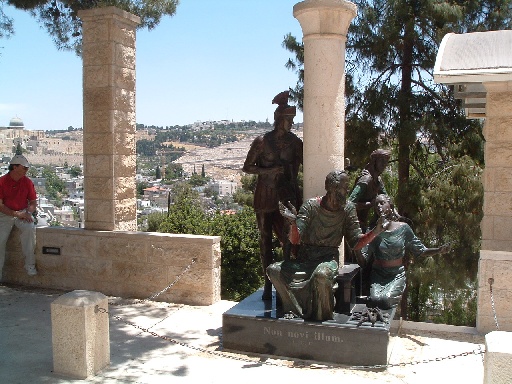
This courtyard area is where Peter could have waited by a fire. In Mark 14:3 it states that They took Jesus to the high priest This house is in the Upper City where the High Priest might have lived.
Also from Mark 14:
Then some began to spit at him; they blindfolded him, struck him with their fistsand the guards took him and beat him
63 Caiaphas Dungeon

This house had a dungeon. Can you see the indents in the archway? Chains hung from these holes. The guards could have chained Jesus here while they beat him.
Very early in the morning, the Chief Priests, with the elders, the teachers of the law and the whole Sanhedrin reached a decision. They bound Jesus, led him away and handed him over to Pilate.
64 Dungeon Pit

Before they reached this decision, they might have kept Jesus in solitary confinement under Caiphas house. This dungeon contains a room that has no doorway. The guards might have lowered Jesus into this pit through the hole in the roof.
Now that youve seen this dungeon, and this pit, lets read Psalm 88:
O Lord, the God who saves me, day and night I cry out before you.
May my prayer come before you; turn your ear to my cry.
For my soul is full of trouble and my life draws near the grave.
I am counted among those who go down to the pit; I am like a man without strength.
I am set apart with the dead, like the slain who lie in the grave, whom you remember no more, who are cut off from your care.
You have put me in the lowest pit, in the darkest depths.
Your wrath lies heavily upon me; you have overwhelmed me with all your waves.
You have taken from me my closest friends and have made me repulsive to them.
I am confined and cannot escape; my eyes are dim with grief.
I call to you, O Lord, every day; I spread out my hands to you.
Do you show your wonders to the dead? [We know that he does!]
Do those who are dead rise up and praise you? [We know that some do!]
Is your love declared in the grave, your faithfulness in destruction? [Yes! His love is declared through Jesus death and destruction!]
Are your wonders known in the place of darkness, or your righteous deeds in the land of oblivion?
But I cry to you for help, O Lord; in the morning my prayer comes before you.
Why, O Lord, do you reject me and hide your face from me?
From my youth I have been afflicted and close to death; I have suffered your terrors and am in despair.
Your wrath has swept over me; your terrors have destroyed me.
All day long they surround me like a flood; they have completely engulfed me.
You have taken my companions and loved ones from me; the darkness is my closest friend.
Read Isaiah 53 when you get home. Its portrayal of Jesus as the man of sorrows, despised and forsaken, stricken by God and afflicted, dovetails nicely with Psalm 88. Clearly those who run and operate Caiaphas house believe this Psalm prefigures the sufferings of Christ. I read four or five commentaries, not one suggested that Psalm 88 refers to Christ. The Bible itself says this is a Psalm of a specific individual, Herman the Ezrahite. That does not mean it could not also be prophetic. So the evidence here is ambivalent.
65 Via Dolorosa

For over a thousand years, believers have walked the Via Dolorosa, or the way of pain. It is a place for prayer and contemplation. A place to remember Jesus suffering and crucifixion. A place to thank Him for His sacrifice for us.
So here we were, on the actual Via Dolorosa. The place so many faithful Christians have imagined in prayer over the centuries. Did we pray? No. Did we contemplate Jesus sufferings and death? Not really. We jogged.
The Seder meal took far longer than our schedule allowed for. This gave our guide only 30 minutes to jog 40 people down the Via Dolorosa. He barely had time to do more than yell, station one! before running again.
Later, Beverly Price said that we cant be sure of the exact path Jesus took, but it had to be close to this one.
The walk was fairly long and some of it went uphill. After being up all night, flogged and beaten with rods, no wonder Jesus couldnt carry the cross.
66 Holy Sepulchre/Site of the Cross

The last five stations of the cross are in the church of the Holy Sepulchre. Our guide said it is a probability # 2 that Jesus was crucified here. It is Biblical and it probably happened here. Six churches share this site today. Over the years, these churches have squabbled to the point of fistfights to control this site. The Muslims grew so tired of Christians seeking their own honor, that a Muslim family kept the key to the church for centuries and opened it every morning so that all Christians could enter.
The Jewish burial ground under this Church is from the time of Christ, though it is not necessarily the correct tomb. From the 3rd century on, Christians believed this to be Jesus burial ground. [That is roughly 300 years after Jesus death. Its been roughly 200 years since Washington died but we havent forgotten where hes buried.]
67 Golgotha

Alternatively, many believe this skull shaped cliff is Golgotha.
68 Garden Tomb
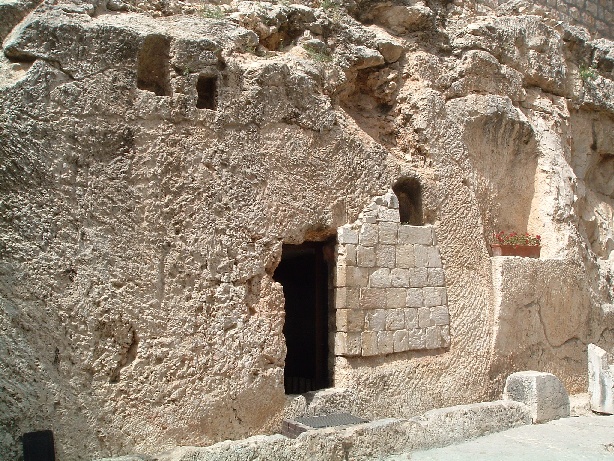
Next to the cliff they found the Garden Tomb. You can see a trench in front of the tomb. A large stone could have rolled in that trench and covered the tomb. No one ever found the actual stone.
Underneath this property, is a very large cistern, the third largest ever found, and the largest wine press ever discovered. So the guide at the Garden tomb believes Joseph of Arimathea, a wealthy man, owned this garden, cistern, wine press and tomb.
Randall Price said that the Garden Tomb dates from the period of the first temple. He believes this eliminates the Garden Tomb because the Bible clearly states that Joseph buried Jesus in a new tomb. From Matthew:
Joseph took the body and wrapped it in a clean linen shroud, and laid it in his own new tomb, which he had hewn in the rock.
Therefore, Dr. Price thinks Jesus was probably buried at the Church of the Holy Sepulcher.
After seeing these sites, I had two questions: Why would a wealthy man buy a tomb so near a spot where they crucified criminals? And why do the Church of the Holy Sepulcher, and the Garden Tomb, both assume that they buried Jesus right where he was crucified? I found the answer to both these question in the book of John:
Now in the place where He was crucified there was a garden; and in the garden a new tomb, in which no one had yet been laid.
The Bible says the tomb and garden lay near the crucifixion site. Oops, I never caught that before!
Caesarea
Did we walk where Paul walked? The Apostle Paul was imprisoned in Caesarea for two years while he awaited his trial before going to Rome.
Some of the ruins we saw in Caesarea included:
69 Harbor

Herods harbor. They dont know exactly how this harbor was built. It didnt have a natural bay. Herods engineers stopped the ocean waves so they could build an underground floor. They even had a concrete that could harden underwater.
70 Aqueduct

Herod build a 10-mile aqueduct to bring water to Caesarea from Mt. Carmel.
71 Herods Pool

This is Herods palace. The square you see is an Olympic sized swimming pool which was filled with fresh water and had a view of the ocean.
72 Tax Office

This is a Byzantine tax office. Wouldnt you just know that the tax office would survive? The Byzantine Mosaic you see contains this scripture passage: For rulers are not a cause of fear for good behavior, but for evil. Do you want to have no fear of authority? Do what is good, and you will have praise from the same, Romans 13:3 So pay your taxes!
73 Masada

This is Masada -- the Jewish Alamo. Jewish Zealots captured Masada and fought the Romans in 73 A.D.
74 Roman Encampments

The square you see towards the top is one of the Roman Encampments from 73 A.D. 10,000 Roman soldiers besieged Masada for three months.
75 Siege Wall

To conquer Masada, the Romans built the siege wall you see on the right. The Jews fought back by rolling down boulders onto the workers. But they discovered that the Romans were using Jewish slaves to build the ramp. Once the Zealots realized this, they could not attack their own people.
It took 90 days for the Romans to complete the siege wall. The Zealots committed suicide rather than surrender. To the Jews, the memory of Masada is like our Alamo. Their mantra is, Masada shall not fall again!
Hal offered another spiritual lesson from Masada. The Jewish Zealots took up the weapons of war to fight for a worldly kingdom. Meanwhile the Old Testament the Zealots revered is full of prophecies concerning the day when God will restore his people.
76 Plains of Armageddon
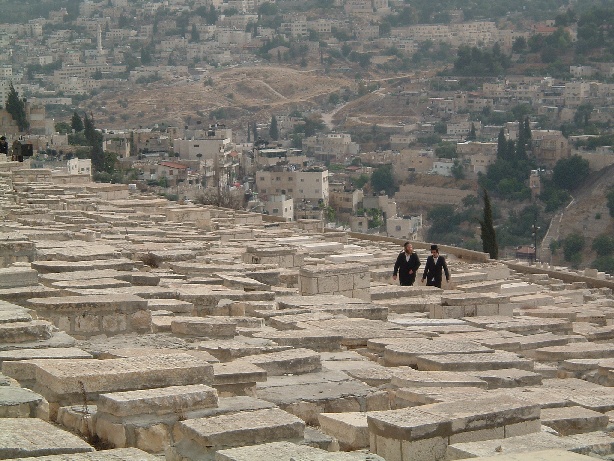
It has been quite a hike. We are in Revelations 16:16 looking at Armageddon. This large, flat area can hold a large amount of military equipment and personnel. According to Dr. Price, you are looking at the staging area for the final battle that all the nations will fight against Jesus. So this is the staging area.
Dr. Price believes the final battle will take place further south near Jerusalem as prophesied in Zechariah 14:2, For I will gather all the nations against Jerusalem to battle. Specifically, some Biblical scholars believe that the battle will occur in the valley of Jehoshaphat or the Kidron valley because of Joel 3:3, Then I will gather all the nations, and bring them down to the valley of Jehoshaphat.
Spiritual Lessons Summarizing our Sight Seeing in Israel
Our guide gave us a wonderful summary of our tour, which I want to pass on to you.
Hal started out by listing many of the Jewish sects during the time of Jesus. For each sect he gave a name, a symbolic place, their self-assessment and his critique. He began with two political extremes, the Herodians and the Zealots.
77 Theater in Caesarea

The Herodians were typified by the Jews at Caesarea. They saw themselves as modern and sophisticated. But they were assimilators. Their faith was cultural not personal. They imitated Roman culture to the point that there was little difference between them and the world.
78 Weapons of War

Zealots were typified by the Jews at Masada. They had a strong faith. They saw themselves as patriots and freedom fighters. But they used the worlds methods (war) to try do defeat their enemy.
Some religious sects:
The Essenes were typified by Qumran. They saw themselves as the sons of light and everybody else as the sons of darkness. They were purists with a strong faith. But the Essenes fled the culture to keep the faith. They had few converts and a small impact on society.
79 Qumran

The Sadducees were typified by the Temple. They saw themselves as religious leaders. They interpreted Judaism as a temple-centered religion rather than a law-centered way of life. They believed that if they were prosperous it was because they were good, and if they had bad luck it was because they were bad. So they were similar to the health and wealth crowd because they believed that their wealth and status proved that they were good.
80 Temple

The Pharisees were typified by their schools of learning. They valued knowledge of God and His will and tried to apply it to this life. Jesus affirmed the Pharisees teaching by saying do what they say, but not what they do. Jesus also said they sit on the seat of Moses, so they provided valuable teaching. But they compartmentalized their life so that they were hypocrites.
81 Jesus Praying in Gethsemane

The Christians were typified not by a place, but by the heart. Christians are followers of Jesus. The Christian life is only possible through Christ living in us.
Other sects sought God through their own efforts (and we can do the same today): The Pharisees used faith to impress others, the Sadducees take pride in wealth, Essenes can be isolationists, Herodians we can be assimilators, Zealots use worldly weapons to attack spiritual foes. Christians allow God to transform hearts, credit God for the blessings in our lives, strive to have relationships with unbelievers, realize that you cannot live the Christian life by yourself (the only one who did is Jesus) and allow God and the Holy Spirit to live in you so you live a good Christian life and then outsiders will see a difference between a Christian and the world.
Thank you from Stefanie who put together this presentation.




